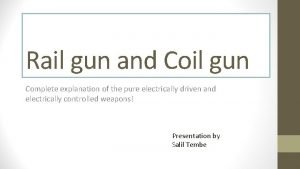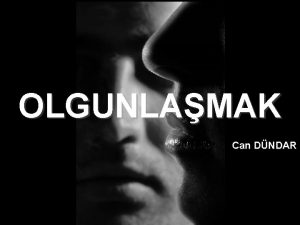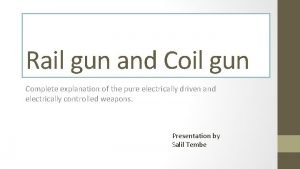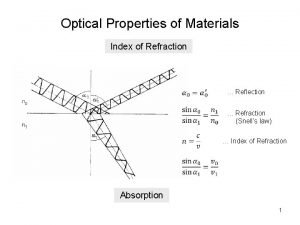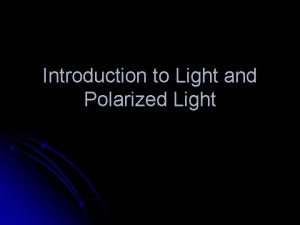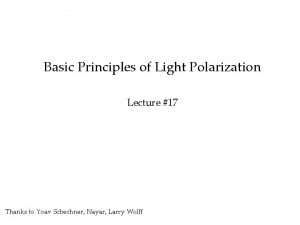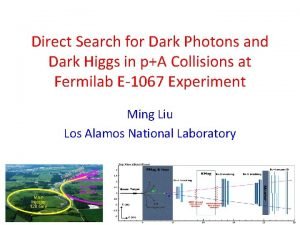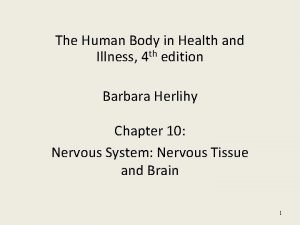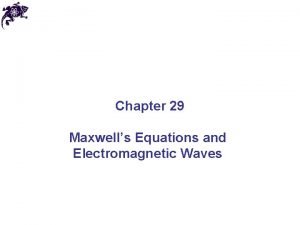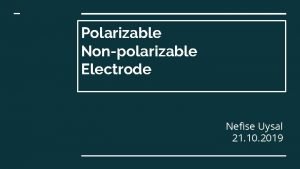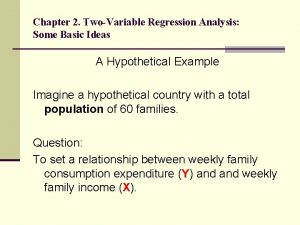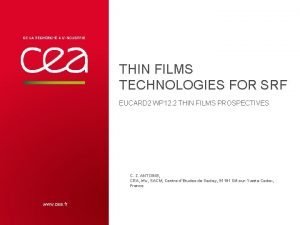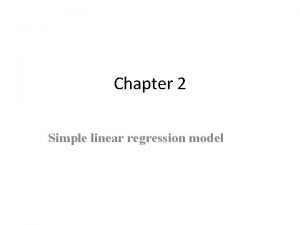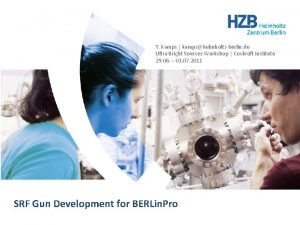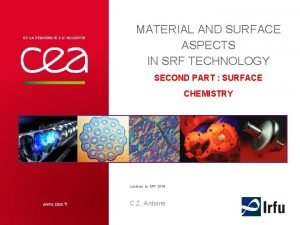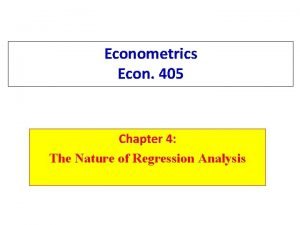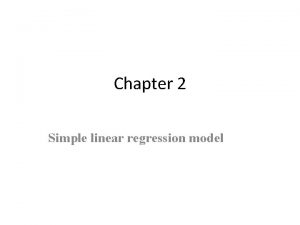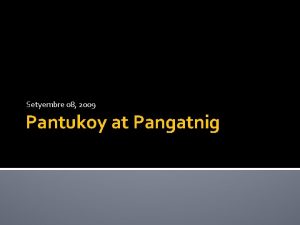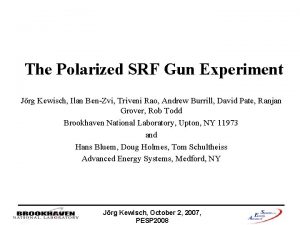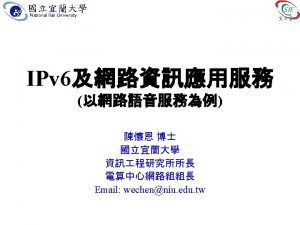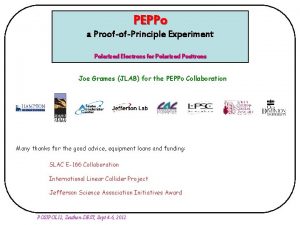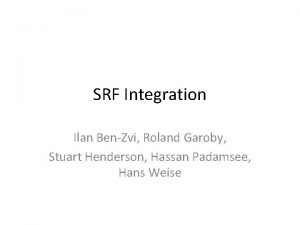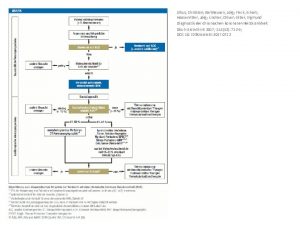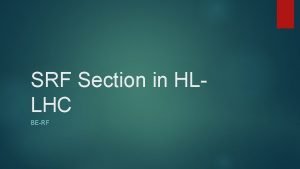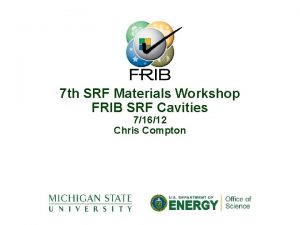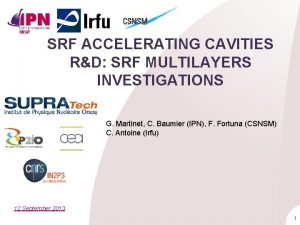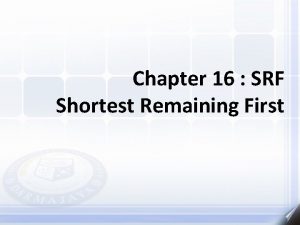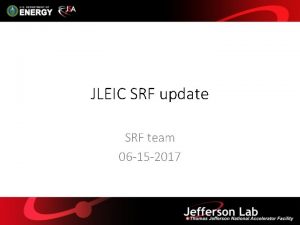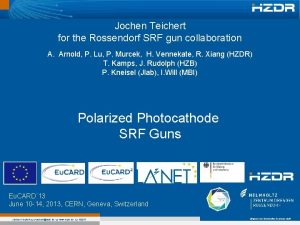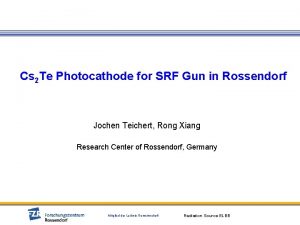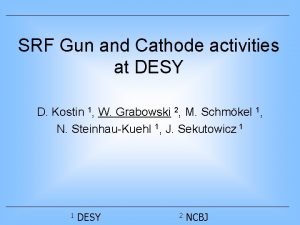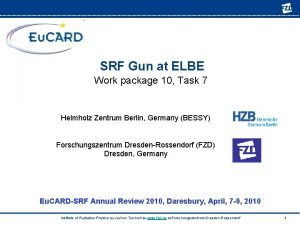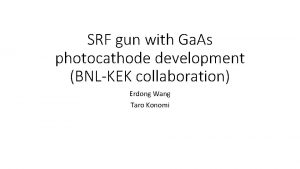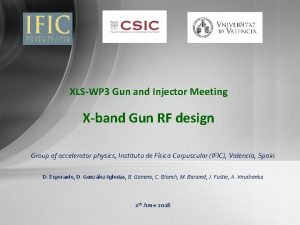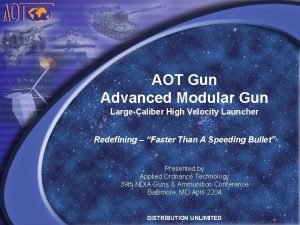The Polarized SRF Gun Experiment Jrg Kewisch Ilan























- Slides: 23

The Polarized SRF Gun Experiment Jőrg Kewisch, Ilan Ben-Zvi, Triveni Rao, Andrew Burrill, David Pate, Ranjan Grover, Rob Todd Brookhaven National Laboratory, Upton, NY 11973 and Hans Bluem, Doug Holmes, Tom Schultheiss Advanced Energy Systems, Medford, NY Jörg Kewisch, September 26, 2007

Abstract RF electron guns are capable of producing electron bunches with high brightness, which outperform DC electron guns and may even be able to provide electron beams for the ILC without the need for a damping ring. However, all successful existing guns for polarized electrons are DC guns because the environment inside is RF gun is hostile to the Ga. As cathode material necessary for polarization. While the typical vacuum pressure in a DC gun is better than 10 -11 torr the vacuum in an RF gun is in the order of 10 -9 torr. Experiments at BINP show that this leads to strong ion back-bombardment and generation of dark currents, which destroy the Ga. AS cathode in a short time. The situation might be much more favorable in a (super-conducting) SRF gun. The cryogenic pumping of the gun cavity walls may make it possible to maintain a vacuum close to 10 -12 torr, solving the problem of ion bombardment and dark currents. Of concern would be in this case contamination of the gun cavity by evaporating cathode material. This report describes an experiment that BNL (in collaboration with AES) is conducting to answer these questions. Parmela simulations show promising results. Jörg Kewisch, September 26, 2007

BINP experiment Aleksandrov, et al. • Normal conducting gun • Pressure 2*10 -10 torr at before RF is turned on. • Large dark current cause by ion bombardment of NEA surface • Quantum efficiency life time a few seconds • RF field of 30 MV/m does no irreversible damage 1 activation chamber, 2 photo-cathode assembly, 3 manipulator, 4 accelerating cavity, 5 wave guide, 6 focusing lens, 7 transverse corrector, 8 working chamber, 9 vacuum window for laser beam, 10 ceramic insulator, 11 the cavity for bunch length measurement. Jörg Kewisch, September 26, 2007

How Many Ions Impact Cathode in RF Gun? (Ray Fliller at Snowmass) • MAGIC predicts 2. 8 x 107 ions/C, generated from beam, impacting the cathode at a partial pressure of 10 -10 torr. Dark current produced a bombarding ion flux of 1. 6 x 107 ions/C at 1010 torr. – In contrast, a DC gun produces on the order of 3 x 107 ions/C striking the cathode at 10 -11 torr. • The RF gun seems to have an order of magnitude less in the number of ions impacting cathode at the same pressure. – However RF guns typically run in 10 -9 torr range. • In addition, the maximum ion energy is ~2 ke. V in the RF gun. Dark current generated ions generally have energies less than 500 e. V. – Max ion energy in DC gun ~100 ke. V – Higher mass of ions means they quickly slip relative to the RF phase, as opposed to the continual acceleration in a DC gun. • An RF gun should be able to support an Ga. As cathode at pressures higher then a DC gun, but lower than current RF guns. Jörg Kewisch, September 26, 2007

Fermilab’s cold RF gun (Ray Fliller at Snowmass) • Liquid N 2 cooled • Base pressure of uncooled, no RF, gun is 3 x 10 -10 torr • When RF applied to uncooled gun, most gases show increased outgassing. Pressure increases to 1. 6 x 10 -9. • Cooling gun to 92 K drops pressure by factor of 2. • Applying RF to cooled gun increases pressure factor of 2, mostly due to methane out-gassing. Pressure slightly less than base pressure. Jörg Kewisch, September 26, 2007

“Getting cold” is not enough (R. Fliller at Snowmass) • True cryopumping involves – Gas molecules freezing to chamber walls – A reduction in gas vapor pressure below total pressure • Only CH 4, C 2 H 4, CO 2 and H 2 O are frozen at 92 K. • Other gases merely collect in the cold volume, forming a lower pressure, higher density gas than exists in the warm section. • Vapor pressures of the gases involved to not reach 10 -10 -10 -11 torr until 20 -30 K. • Cooling with Liquid He is necessary! Jörg Kewisch, September 26, 2007

Our Experiment • Superconducting ½ cell 1. 3 GHz gun • Beam energy 0. 8 Me. V, current 10 A, limited by availbale RF power • Removable NEA bulk Ga. As cathode, 1 mm diameter. • 100 liter cryostat, helium lasts about 24 hours • Beam exits to on top, is bend 90 degrees into a Faraday cup • Focusing with permanent magnet solenoids • NEG pumps inside the cryostat, close to the gun, expected vacuum close to 10 -12 torr. Jörg Kewisch, September 26, 2007

Cryostat Jörg Kewisch, September 26, 2007

Gun with cathode transporter Jörg Kewisch, September 26, 2007

Cathode connected to the preparation chamber Jörg Kewisch, September 26, 2007

Cathode transporter Jörg Kewisch, September 26, 2007

Clamping the cathode to the gun Jörg Kewisch, September 26, 2007

Cathode plug Jörg Kewisch, September 26, 2007

Tasks Gun base line testing at Jlab without hole Design plug and modification. Modify and machine gun, clean at JLab or AES Test cryostat Test Ga. As attached to Nb (no gun) Base line testing with Nb plug, cold, low power RF, measure Q, impedance High power RF test with Nb plug Bates preparation chamber Low/high power RF test with Nb/Ga. As plug, no Cs Low/high power RF test with Nb/Ga. As/Cs plug Our preparation chamber Transport system Run experiment with Laser Jörg Kewisch, September 26, 2007

Magnetization • We define the magnetization generated by the magnetic field on the cathode as: The angled brackets indicate the average over all electrons. According to Busch’s Theorem the magnetization is a constant of motion outside longitudinal fields when only axial symmetric fields are present. • We also define the 4 D emittance as the forth root of the determinate of the sigma matrix: with Jörg Kewisch, September 26, 2007

Round to Flat conversion • The beam will then have an effective emittance of: • After the round-to-flat converter the beam has the horizontal and vertical emittances of: and • Given those equations we calculate the necessary 4 D emittance and magnetization for an ILC injector: and Kwang-Je Kim: Round-to-flat transformation of angular-momentum-dominated beams. Phys. Rev. ST, 6, 104002 Jörg Kewisch, September 26, 2007

Proof of principle • 700 MHz gun and linac • M=10μ, ε 4 d=1μ • Conversion at 20 Me. V • Energy spread 3. 6*10 -3 • Space charge still importatnt Jörg Kewisch, September 26, 2007

Best so far Jörg Kewisch, September 26, 2007

Jörg Kewisch, September 26, 2007

Jörg Kewisch, September 26, 2007

Parameters • Gun frequency: 350 MHz • Linac Frequency 700 MHz (working on 350 MHz) • Bunch length: ± 13. 3 degrees • Cathode radius: 6. 3 mm • Transverse temperature on the cathode: 0. 03 e. V (this corresponds to a cathode temperature of 80 deg K. The expected temperature in our experiment is about 3 deg K. • Field on the cathode: 11. 2 Gauss • Magnetization 5 μ (not much increase expected for 8 μ) • Energy at the exit of the gun: 5 Me. V • Further optimization possible (gun shape, frequency, linac) Jörg Kewisch, September 26, 2007

Including a Solenoid in the gun Jörg Kewisch, September 26, 2007

Conclusion • Promising simulations indicate better than required 4 D-emittance, leaving budget for the real world. • Expectation that the experiment proves the feasability of Ga. As SRF guns. • Experiment progressing on a shoe-string budget Jörg Kewisch, September 26, 2007
 Rail gun vs coil gun
Rail gun vs coil gun Kötü gün sözleri
Kötü gün sözleri Coil gun
Coil gun Index of refraction formula
Index of refraction formula Polarized light definition
Polarized light definition Polarized wave
Polarized wave Polarized pluralist model
Polarized pluralist model Dark sector upgrades
Dark sector upgrades Polarized vs depolarized neurons
Polarized vs depolarized neurons A polarizer blocks 75% of a polarized light beam.
A polarizer blocks 75% of a polarized light beam. Non-polarizable electrode
Non-polarizable electrode Srf guided meditations
Srf guided meditations Sample regression function
Sample regression function Srf
Srf Sample regression function
Sample regression function Srf
Srf Srf aimsweb
Srf aimsweb Scnc3111
Scnc3111 Srf
Srf What is srf in econometrics
What is srf in econometrics What is srf in econometrics
What is srf in econometrics Ano ang epiko
Ano ang epiko Ano ang pamatnubay
Ano ang pamatnubay Mga pangatnig
Mga pangatnig
